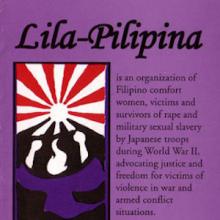Contemporary (1950 CE - Present)

Long Teaching Module: “Reading” Primary Sources on the History of Children & Youth
How do you study the history of young people? What can primary source documents reveal? What limitations do they pose? What light can the history of young people shed on the past?

Piglas-Diwa newsletter/booklet
The Piglas-Diwa newsletter/booklet is a creation of the feminist group of Filipino “comfort women" called Lila-Pilipina, who have banded together with feminist goals/messages for peace.

Short Teaching Module: Filipino Comfort Women
This lesson on Filipino “comfort women” fits into a women’s history course. I chose this topic because it exposes the false dichotomy between being a victim and being a forceful advocate for your cause.
Short Teaching Module: Letters of Milada Horáková
Horáková makes a good case study for several reasons. One of the most prominent European feminists of the first half of the 20th century, she was an active member of the resistance during the Nazi occupation of Czechoslovakia.
Letters of Milada Horáková
In this collection of letters, written by Milada Horáková before her execution in 1950 by the Communist Party in Czechoslovakia, Horáková writes last wishes and notes to her family.

Long Teaching Module: The Romanian Revolution of 1989
The December 1989 revolution in Romania has been the subject of scholarly discussions, passionate debates, conspiracy theories, and political struggles.

Morning Sun
This companion site provides a wonderful introduction to 'the psycho-emotional topography of high-Maoist China.'
Short Teaching Module: Consumerism in Poland
Throughout Eastern Europe, the decade of the 1980s was a time of significant change, including the everyday lives of average citizens.
Short Teaching Module: Memory in East Germany
This case study examines how a group of East German dissidents re-appropriated the memory of Rosa Luxemburg and turned her writing against the Communist Party during an annual parade in January 1988.
Short Teaching Module: Reagan at the Brandenburg Gate
In June 1987, President Reagan delivered an important speech in front of the Brandenburg Gate in West Berlin. This case study looks at how to use the speech as a means to examine US foreign policy and the end of the Cold War.